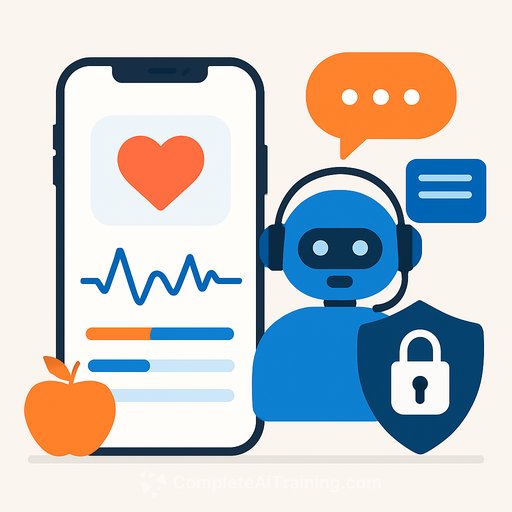GE HealthCare's AI Push: A Practical Shift in Clinical Workflow Strategy?
GE HealthCare announced three moves in quick succession: CareIntellect for Perinatal, the Carestation 850 anesthesia system, and a collaboration with SmartAlpha to commercialize Nerveblox, an AI-assisted ultrasound solution for regional anesthesia. The common thread is clear-pair advanced analytics with workflow tools to reduce clinician workload and expand access across care settings.
For healthcare leaders, the question is simple: do these launches make daily work safer, faster, and more consistent without adding bloat to tech stacks? Here's how to assess the signal through the noise.
What This Means for Clinical Teams
- Perinatal workflow: CareIntellect for Perinatal extends GE's digital SaaS footprint into cloud-based clinical support. Expect decision support, streamlined handoffs, and tighter situational awareness across labor and delivery.
- Anesthesia operations: Carestation 850 is positioned as an integrated anesthesia workstation. Look for cleaner data capture, better device interoperability, and fewer manual steps from induction to emergence.
- Regional anesthesia: Nerveblox brings AI guidance to ultrasound for nerve blocks. Potential benefits include faster block placement, higher first-pass success, and easier skill transfer for newer clinicians-while keeping the clinician in control.
Workflow Integration: Questions to Settle Early
- Interoperability: Confirm HL7, FHIR, and DICOM support. Test end-to-end data flow with your EHR, PACS, and anesthesia information systems.
- Cloud and PHI: Validate HIPAA requirements, data residency, encryption, and downtime procedures. Check latency and offline contingencies for critical workflows.
- Cybersecurity: Request SBOMs, patching schedules, and incident response playbooks. Ensure role-based access and MFA across all consoles.
- Change management: Map current-state workflows and remove redundant steps before you add new tools. Tech should subtract friction, not add it.
Clinical and Operational KPIs to Track
- Perinatal: Time-to-notification for concerning trends, documentation time per patient, escalation-to-intervention intervals, and alarm-to-action precision.
- Anesthesia: First-case on-time starts, turnover time, low-flow utilization rates, unplanned ICU admissions, and documentation completeness.
- Regional anesthesia: Block success rate, time to readiness for surgery, conversion to general anesthesia, and complication rates (vascular puncture, LAST, paresthesia).
- Staff impact: Nurse and anesthesiologist time saved per case, training time to competency, and user satisfaction scores.
Procurement and ROI: What to Price In
- Total cost of ownership: Hardware, SaaS subscriptions, service contracts, disposables, and integration work. Model 5-7 years, not 12 months.
- Utilization: Tie licensing to actual volumes and staffing patterns. Avoid paying for dormant features.
- Training and credentialing: Budget for simulation time, competency checks, and refresher training for new cohorts.
- Outcome-tied clauses: Where possible, negotiate service or training credits tied to KPI improvements you can measure.
Safety, Quality, and Regulatory Checklist
- Regulatory status: Verify FDA clearance/510(k) for each feature in your intended use. Confirm update cadence and change control for AI models.
- Human-in-the-loop: Keep clinicians as final decision-makers. Document override protocols and escalation paths.
- Bias and performance: Review validation data across patient demographics and body habitus. Require site-level performance monitoring.
- Alarm governance: Measure alert volume, signal-to-noise, and alarm fatigue. Tune thresholds with clinical leadership.
Does This Shift Change the Vendor Risk Picture?
GE HealthCare's strategy leans into AI plus workflow to support margin stability via recurring SaaS and stickier integrations. That can be good for hospitals if it delivers measurable time savings and fewer complications. External pressures-tariffs and rising operating costs-still affect pricing and delivery timelines, so build lead-time and price buffers into your plans.
Bottom line: the value shows up only if your team adopts the tools and your data flows cleanly. Pilot before you standardize.
90-Day Action Plan for Healthcare Leaders
- Run two pilots: one in L&D (CareIntellect) and one in OR/regional anesthesia (Nerveblox + Carestation data capture).
- Lock KPIs pre-pilot. Track throughput, event detection time, block success, staff time saved, and documentation completeness.
- Stand up an AI governance huddle: anesthesia, L&D, IT, risk, and quality. Decide thresholds, overrides, and retraining schedules.
- Validate integrations in a staging environment. Test failure modes and downtime procedures.
- Plan training at the point of care. Short modules, checklists, and quick-reference guides beat long lectures.
Forecasts and Valuation Context
The current narrative pegs GE HealthCare at about $22.7B in revenue and $2.5B in earnings by 2028. That implies roughly 4.3% annual revenue growth and a $0.3B earnings step-up from an estimated $2.2B base.
Some models put fair value near $86.96 per share, which would be about 17% above recent trading levels. Community estimates span roughly $62 to $123 per share as of Oct 2025, reflecting wide assumptions about margin improvement and product adoption.
This information is for general analysis, not financial advice. Use your organization's capital plans and risk policies to guide purchasing and contracting.
Helpful Resources
Upskill Your Team
If you're building internal capability for AI-driven clinical operations, explore practical training paths by role.
Your membership also unlocks:






